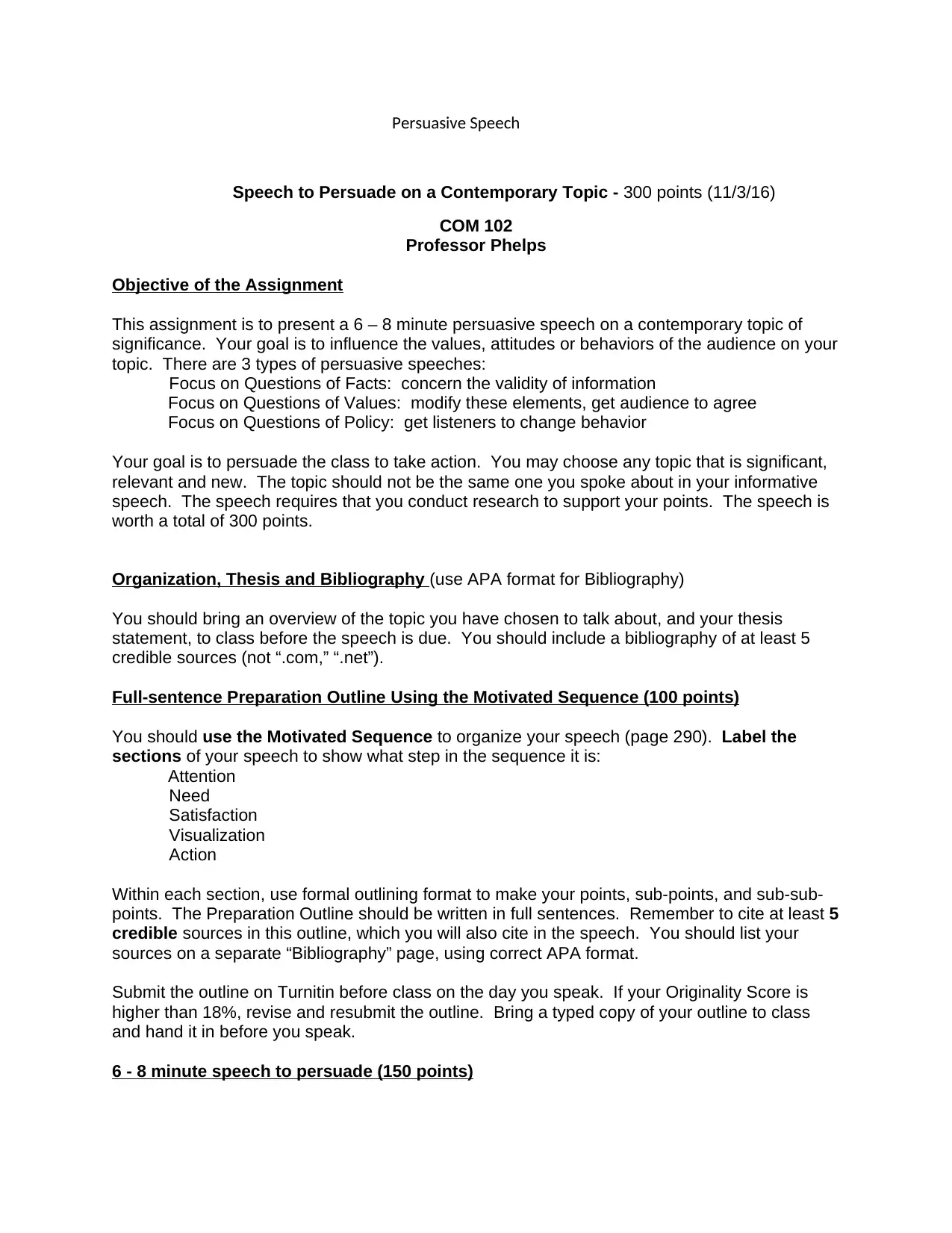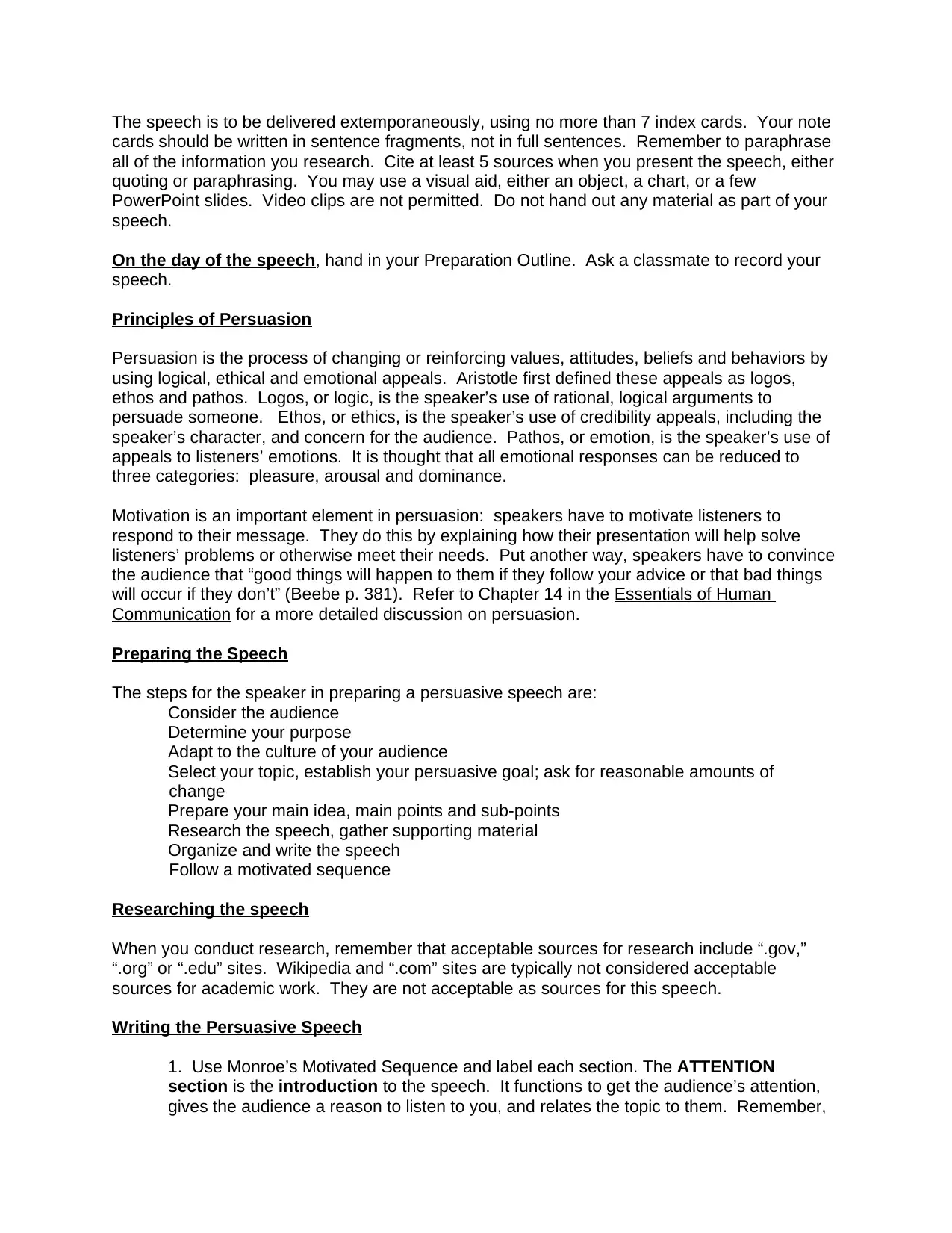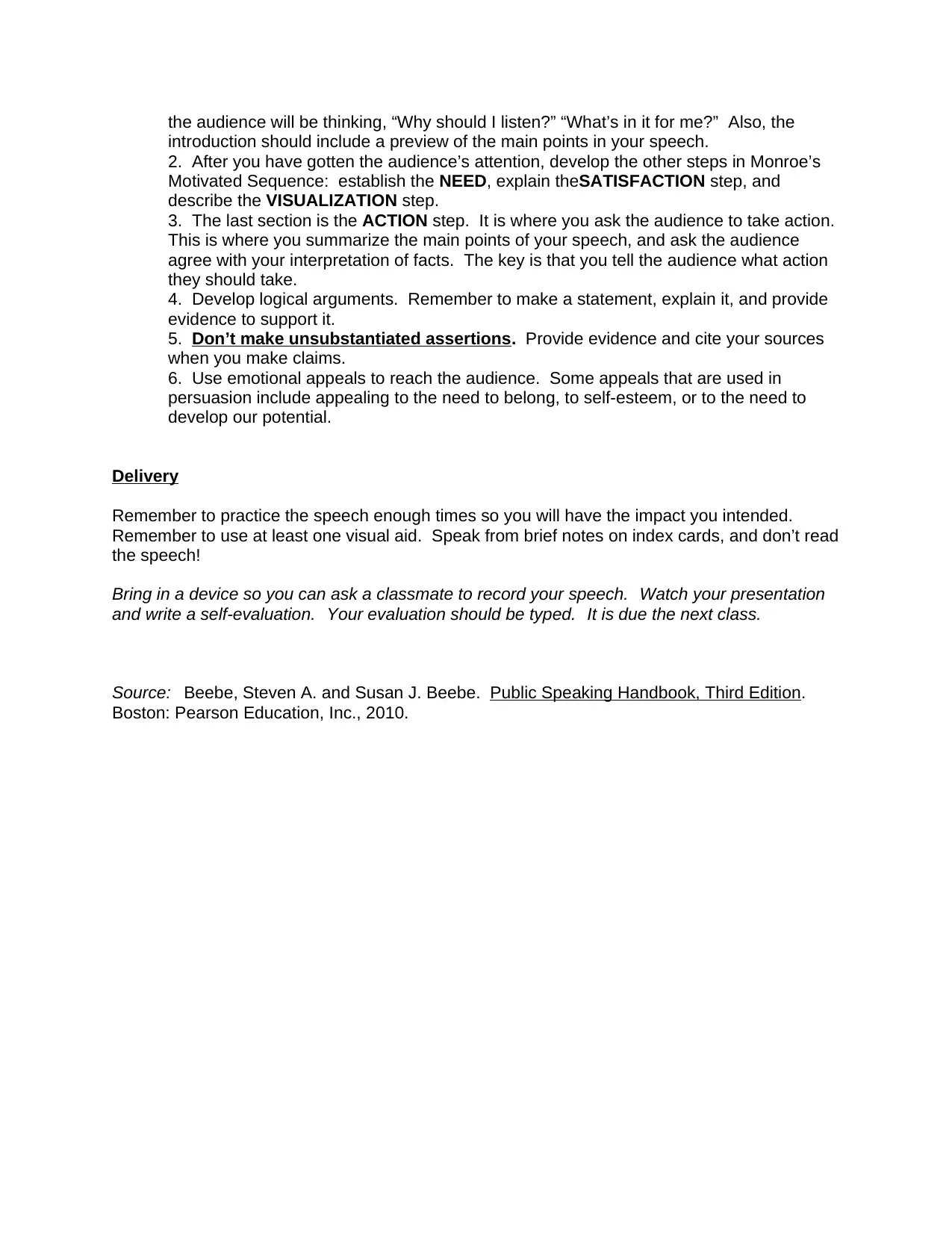COM 102 Persuasive Speech Assignment
VerifiedAdded on 2019/09/18
|3
|1234
|526
Presentation
AI Summary
This document outlines the requirements for a persuasive speech assignment in COM 102. The assignment requires students to deliver a 6-8 minute persuasive speech on a contemporary topic, using Monroe's Motivated Sequence for organization. Students must submit a full-sentence preparation outline, including a bibliography of at least 5 credible sources, and deliver the speech extemporaneously using note cards. The assignment also emphasizes the principles of persuasion, including logical, ethical, and emotional appeals, and requires students to record their speech and write a self-evaluation. The document provides detailed instructions on how to prepare, research, and deliver the speech effectively.

Persuasive Speech
Speech to Persuade on a Contemporary Topic - 300 points (11/3/16)
COM 102
Professor Phelps
Objective of the Assignment
This assignment is to present a 6 – 8 minute persuasive speech on a contemporary topic of
significance. Your goal is to influence the values, attitudes or behaviors of the audience on your
topic. There are 3 types of persuasive speeches:
Focus on Questions of Facts: concern the validity of information
Focus on Questions of Values: modify these elements, get audience to agree
Focus on Questions of Policy: get listeners to change behavior
Your goal is to persuade the class to take action. You may choose any topic that is significant,
relevant and new. The topic should not be the same one you spoke about in your informative
speech. The speech requires that you conduct research to support your points. The speech is
worth a total of 300 points.
Organization, Thesis and Bibliography (use APA format for Bibliography)
You should bring an overview of the topic you have chosen to talk about, and your thesis
statement, to class before the speech is due. You should include a bibliography of at least 5
credible sources (not “.com,” “.net”).
Full-sentence Preparation Outline Using the Motivated Sequence (100 points)
You should use the Motivated Sequence to organize your speech (page 290). Label the
sections of your speech to show what step in the sequence it is:
Attention
Need
Satisfaction
Visualization
Action
Within each section, use formal outlining format to make your points, sub-points, and sub-sub-
points. The Preparation Outline should be written in full sentences. Remember to cite at least 5
credible sources in this outline, which you will also cite in the speech. You should list your
sources on a separate “Bibliography” page, using correct APA format.
Submit the outline on Turnitin before class on the day you speak. If your Originality Score is
higher than 18%, revise and resubmit the outline. Bring a typed copy of your outline to class
and hand it in before you speak.
6 - 8 minute speech to persuade (150 points)
Speech to Persuade on a Contemporary Topic - 300 points (11/3/16)
COM 102
Professor Phelps
Objective of the Assignment
This assignment is to present a 6 – 8 minute persuasive speech on a contemporary topic of
significance. Your goal is to influence the values, attitudes or behaviors of the audience on your
topic. There are 3 types of persuasive speeches:
Focus on Questions of Facts: concern the validity of information
Focus on Questions of Values: modify these elements, get audience to agree
Focus on Questions of Policy: get listeners to change behavior
Your goal is to persuade the class to take action. You may choose any topic that is significant,
relevant and new. The topic should not be the same one you spoke about in your informative
speech. The speech requires that you conduct research to support your points. The speech is
worth a total of 300 points.
Organization, Thesis and Bibliography (use APA format for Bibliography)
You should bring an overview of the topic you have chosen to talk about, and your thesis
statement, to class before the speech is due. You should include a bibliography of at least 5
credible sources (not “.com,” “.net”).
Full-sentence Preparation Outline Using the Motivated Sequence (100 points)
You should use the Motivated Sequence to organize your speech (page 290). Label the
sections of your speech to show what step in the sequence it is:
Attention
Need
Satisfaction
Visualization
Action
Within each section, use formal outlining format to make your points, sub-points, and sub-sub-
points. The Preparation Outline should be written in full sentences. Remember to cite at least 5
credible sources in this outline, which you will also cite in the speech. You should list your
sources on a separate “Bibliography” page, using correct APA format.
Submit the outline on Turnitin before class on the day you speak. If your Originality Score is
higher than 18%, revise and resubmit the outline. Bring a typed copy of your outline to class
and hand it in before you speak.
6 - 8 minute speech to persuade (150 points)
Paraphrase This Document
Need a fresh take? Get an instant paraphrase of this document with our AI Paraphraser

The speech is to be delivered extemporaneously, using no more than 7 index cards. Your note
cards should be written in sentence fragments, not in full sentences. Remember to paraphrase
all of the information you research. Cite at least 5 sources when you present the speech, either
quoting or paraphrasing. You may use a visual aid, either an object, a chart, or a few
PowerPoint slides. Video clips are not permitted. Do not hand out any material as part of your
speech.
On the day of the speech, hand in your Preparation Outline. Ask a classmate to record your
speech.
Principles of Persuasion
Persuasion is the process of changing or reinforcing values, attitudes, beliefs and behaviors by
using logical, ethical and emotional appeals. Aristotle first defined these appeals as logos,
ethos and pathos. Logos, or logic, is the speaker’s use of rational, logical arguments to
persuade someone. Ethos, or ethics, is the speaker’s use of credibility appeals, including the
speaker’s character, and concern for the audience. Pathos, or emotion, is the speaker’s use of
appeals to listeners’ emotions. It is thought that all emotional responses can be reduced to
three categories: pleasure, arousal and dominance.
Motivation is an important element in persuasion: speakers have to motivate listeners to
respond to their message. They do this by explaining how their presentation will help solve
listeners’ problems or otherwise meet their needs. Put another way, speakers have to convince
the audience that “good things will happen to them if they follow your advice or that bad things
will occur if they don’t” (Beebe p. 381). Refer to Chapter 14 in the Essentials of Human
Communication for a more detailed discussion on persuasion.
Preparing the Speech
The steps for the speaker in preparing a persuasive speech are:
Consider the audience
Determine your purpose
Adapt to the culture of your audience
Select your topic, establish your persuasive goal; ask for reasonable amounts of
change
Prepare your main idea, main points and sub-points
Research the speech, gather supporting material
Organize and write the speech
Follow a motivated sequence
Researching the speech
When you conduct research, remember that acceptable sources for research include “.gov,”
“.org” or “.edu” sites. Wikipedia and “.com” sites are typically not considered acceptable
sources for academic work. They are not acceptable as sources for this speech.
Writing the Persuasive Speech
1. Use Monroe’s Motivated Sequence and label each section. The ATTENTION
section is the introduction to the speech. It functions to get the audience’s attention,
gives the audience a reason to listen to you, and relates the topic to them. Remember,
cards should be written in sentence fragments, not in full sentences. Remember to paraphrase
all of the information you research. Cite at least 5 sources when you present the speech, either
quoting or paraphrasing. You may use a visual aid, either an object, a chart, or a few
PowerPoint slides. Video clips are not permitted. Do not hand out any material as part of your
speech.
On the day of the speech, hand in your Preparation Outline. Ask a classmate to record your
speech.
Principles of Persuasion
Persuasion is the process of changing or reinforcing values, attitudes, beliefs and behaviors by
using logical, ethical and emotional appeals. Aristotle first defined these appeals as logos,
ethos and pathos. Logos, or logic, is the speaker’s use of rational, logical arguments to
persuade someone. Ethos, or ethics, is the speaker’s use of credibility appeals, including the
speaker’s character, and concern for the audience. Pathos, or emotion, is the speaker’s use of
appeals to listeners’ emotions. It is thought that all emotional responses can be reduced to
three categories: pleasure, arousal and dominance.
Motivation is an important element in persuasion: speakers have to motivate listeners to
respond to their message. They do this by explaining how their presentation will help solve
listeners’ problems or otherwise meet their needs. Put another way, speakers have to convince
the audience that “good things will happen to them if they follow your advice or that bad things
will occur if they don’t” (Beebe p. 381). Refer to Chapter 14 in the Essentials of Human
Communication for a more detailed discussion on persuasion.
Preparing the Speech
The steps for the speaker in preparing a persuasive speech are:
Consider the audience
Determine your purpose
Adapt to the culture of your audience
Select your topic, establish your persuasive goal; ask for reasonable amounts of
change
Prepare your main idea, main points and sub-points
Research the speech, gather supporting material
Organize and write the speech
Follow a motivated sequence
Researching the speech
When you conduct research, remember that acceptable sources for research include “.gov,”
“.org” or “.edu” sites. Wikipedia and “.com” sites are typically not considered acceptable
sources for academic work. They are not acceptable as sources for this speech.
Writing the Persuasive Speech
1. Use Monroe’s Motivated Sequence and label each section. The ATTENTION
section is the introduction to the speech. It functions to get the audience’s attention,
gives the audience a reason to listen to you, and relates the topic to them. Remember,

the audience will be thinking, “Why should I listen?” “What’s in it for me?” Also, the
introduction should include a preview of the main points in your speech.
2. After you have gotten the audience’s attention, develop the other steps in Monroe’s
Motivated Sequence: establish the NEED, explain theSATISFACTION step, and
describe the VISUALIZATION step.
3. The last section is the ACTION step. It is where you ask the audience to take action.
This is where you summarize the main points of your speech, and ask the audience
agree with your interpretation of facts. The key is that you tell the audience what action
they should take.
4. Develop logical arguments. Remember to make a statement, explain it, and provide
evidence to support it.
5. Don’t make unsubstantiated assertions. Provide evidence and cite your sources
when you make claims.
6. Use emotional appeals to reach the audience. Some appeals that are used in
persuasion include appealing to the need to belong, to self-esteem, or to the need to
develop our potential.
Delivery
Remember to practice the speech enough times so you will have the impact you intended.
Remember to use at least one visual aid. Speak from brief notes on index cards, and don’t read
the speech!
Bring in a device so you can ask a classmate to record your speech. Watch your presentation
and write a self-evaluation. Your evaluation should be typed. It is due the next class.
Source: Beebe, Steven A. and Susan J. Beebe. Public Speaking Handbook, Third Edition.
Boston: Pearson Education, Inc., 2010.
introduction should include a preview of the main points in your speech.
2. After you have gotten the audience’s attention, develop the other steps in Monroe’s
Motivated Sequence: establish the NEED, explain theSATISFACTION step, and
describe the VISUALIZATION step.
3. The last section is the ACTION step. It is where you ask the audience to take action.
This is where you summarize the main points of your speech, and ask the audience
agree with your interpretation of facts. The key is that you tell the audience what action
they should take.
4. Develop logical arguments. Remember to make a statement, explain it, and provide
evidence to support it.
5. Don’t make unsubstantiated assertions. Provide evidence and cite your sources
when you make claims.
6. Use emotional appeals to reach the audience. Some appeals that are used in
persuasion include appealing to the need to belong, to self-esteem, or to the need to
develop our potential.
Delivery
Remember to practice the speech enough times so you will have the impact you intended.
Remember to use at least one visual aid. Speak from brief notes on index cards, and don’t read
the speech!
Bring in a device so you can ask a classmate to record your speech. Watch your presentation
and write a self-evaluation. Your evaluation should be typed. It is due the next class.
Source: Beebe, Steven A. and Susan J. Beebe. Public Speaking Handbook, Third Edition.
Boston: Pearson Education, Inc., 2010.
⊘ This is a preview!⊘
Do you want full access?
Subscribe today to unlock all pages.

Trusted by 1+ million students worldwide
1 out of 3
Related Documents
Your All-in-One AI-Powered Toolkit for Academic Success.
+13062052269
info@desklib.com
Available 24*7 on WhatsApp / Email
![[object Object]](/_next/static/media/star-bottom.7253800d.svg)
Unlock your academic potential
Copyright © 2020–2025 A2Z Services. All Rights Reserved. Developed and managed by ZUCOL.





